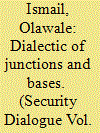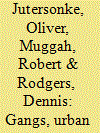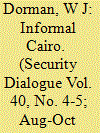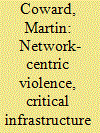|
|
|
Sort Order |
|
|
|
Items / Page
|
|
|
|
|
|
|
| Srl | Item |
| 1 |
ID:
092062


|
|
|
|
|
| Publication |
2009.
|
| Summary/Abstract |
This article examines the involvement of youth - constructed as 'area boys' and 'area girls' - in crises of order in downtown Lagos. It explores the emergence of 'bases' and 'junctions' as modes of organization and differentiation between and among youth in urban Lagos. A 'base' is a neighbourhood meeting place where youths gather to relax, recreate, and discuss sports and politics. A 'junction' is where social miscreants, street marauders and touts congregate to exploit money-making opportunities. It is my argument that bases and junctions embody distinct, yet connected, forms of subcultures that are simultaneously imbibed and projected by members. Moreover, they constitute emergent forms of territoriality constructed around spaces of leisure, residence and commerce, manifested in extrastate regimes of (dis)order in downtown Lagos. The article unpacks the involvement of members of junctions and bases in the provision of (dis)order as 'securo-commerce' - payment of different kinds of fees and levies to purchase security or forestall insecurity in downtown Lagos.
|
|
|
|
|
|
|
|
|
|
|
|
|
|
|
|
| 2 |
ID:
092056


|
|
|
|
|
| Publication |
2009.
|
| Summary/Abstract |
Urban violence is a major preoccupation of policymakers, planners and development practitioners in cities around the world. Public authorities routinely seek to contain such violence through repression, as well as through its exportation to and containment at the periphery of metropolitan centres. Yet, urban violence is a highly heterogeneous phenomenon and not amenable to reified diagnosis and coercive intervention. Muscular state-led responses tend to overlook and conceal the underlying factors shaping the emergence of urban violence, as well as the motivations and means of so-called violence entrepreneurs. This is very obviously the case of urban gangs in Central America, which are regularly labelled a 'new urban insurgency' threatening the integrity of governments and public order. This article considers both the shape and character of Central American gang violence and attempts to reduce it, highlighting the complex relationship between these two phenomena. We advance a threefold approach to measuring the effectiveness of interventions, focusing in turn on discursive, practical and outcome-based criteria. In this way, the article demonstrates how, contrary to their reported success in diminishing gang violence, repressive first-generation approaches have tended instead to radicalize gangs, potentially pushing them towards more organized forms of criminality. Moreover, although credited with some modest successes, more preventive second-generation interventions seem to have yielded more rhetorical advances than meaningful reductions in gang violence.
|
|
|
|
|
|
|
|
|
|
|
|
|
|
|
|
| 3 |
ID:
092059


|
|
|
|
|
| Publication |
2009.
|
| Summary/Abstract |
From the late 1980s, Islamist militants established a 'state within the state' in the Egyptian capital Cairo, situated in 'informal' neighbourhoods developed without official authorization, planning or public services. After government security forces in late 1992 crushed these efforts in the neighbourhood of Munira Gharbiyya, informal Cairo became pathologized in public discourse as ashwa'iyyat ('random' or 'haphazard' areas), a zone of socio-spatial disorder threatening Egypt as a whole and demanding state intervention. However, this securitizing move did not lead to heavy-handed intervention against informal Cairo more generally. Following the suppression of the militants, the Mubarak government instead returned to long-term patterns of indifference and neglect that had allowed informal neighbourhoods to flourish since the 1960s. In part, the absence of intervention can be explained in terms of resource constraints and risk avoidance. More profoundly, however, it reflects numerous linkages between informal urbanization and the Egyptian state. The ashwa'iyyat are, to a significant degree, both a consequence of an authoritarian political order and embedded in the informal control stratagems used by Egyptian governments to bolster their rule. Informal Cairo should thus not be understood as a disorderly zone of subaltern dissidence. Rather, the Egyptian state is best seen as facing its own oblique reflection.
|
|
|
|
|
|
|
|
|
|
|
|
|
|
|
|
| 4 |
ID:
092060


|
|
|
|
|
| Publication |
2009.
|
| Summary/Abstract |
This article locates the contemporary security climate of the city of Los Angeles within a historical trajectory of modes of securitization. While some of the analysis treats the material and technological aspects of cities in general, and Los Angeles in particular, much of my emphasis, articulated in readings of both literary and film versions of police procedurals, is on discursive barriers. Ultimately, I suggest that, materially and discursively, urban America features class and ethnic fault lines that serve as the primary bases of security management.
|
|
|
|
|
|
|
|
|
|
|
|
|
|
|
|
| 5 |
ID:
092058


|
|
|
|
|
| Publication |
2009.
|
| Summary/Abstract |
This article addresses the question of whether contemporary global urbanization is characterized by a distinctive relationship between the city and warfare. In particular, it examines the specific way in which two particular forms of warfare - so-called Al-Qaeda terrorism and US tactics in Iraq - target urban infrastructure. I argue that infrastructure is targeted because it is a constitutive feature of contemporary urban life. Metropolitan life is marked by its constitutive relation to urban infrastructure. The article thus suggests that this targeting of infrastructure provides a lens through which to investigate some of the central questions posed by the contemporary urbanization of security.
|
|
|
|
|
|
|
|
|
|
|
|
|
|
|
|
| 6 |
ID:
092065


|
|
|
|
|
| Publication |
2009.
|
| Summary/Abstract |
This article develops new insights into the gendered insecurities of the neoliberal state in Latin America by exploring the militarization of public security in Rio de Janeiro during 2003-08 around campaigns to stop the 'trafficking' of sex workers. Findings illuminate the intersection of three neoliberal governance logics: (1) a moralistic humanitarian-rescue agenda promoted by evangelical populists and police groups; (2) a juridical 'law and rights' logic promoted by justice-sector actors and human-rights NGOs; (3) a worker-empowerment logic articulated by the governing Workers' Party (PT) in alliance with social-justice movements, police reformers, and prostitutes' rights groups. Gender and race analyses map the antagonisms between these three logics of neoliberal governance, and how their incommensurabilities generate crisis in the arena of security policy. By exploring Brazil's fraught efforts to attain the status of 'human security superpower' through these interventions, the article challenges the view that the reordering of security politics in the global south is inevitably linked to desecularization, disempowerment, and militarization.
|
|
|
|
|
|
|
|
|
|
|
|
|
|
|
|
| 7 |
ID:
092063


|
|
|
|
|
| Publication |
2009.
|
| Summary/Abstract |
Urban defences against terrorism have traditionally been based on territorial interventions that sought to seal off and surveil certain public and private spaces considered targets. Lately, though, a much wider range of crowded and public spaces have been viewed as potential targets and thus have been identified as requiring additional security. This has immense implications for the experience of the 'everyday' urban landscape. Drawing on contemporary notions that incorporate the study of aesthetics and emotions within critical security and terrorism studies, this article discusses the visual impact of counter-terrorism security measures. It analyses the 'transmission' of symbolic messages, as well as the variety of ways in which security might be 'received' by various stakeholders. The analysis takes place against the backdrop of concern that obtrusive security measures have the capacity to radically alter public experiences of space and in some cases lead to (intended and unintended) exclusionary practices or a range of negative emotional responses. The article concludes by outlining a 'spectrum of visible security' ranging between traditional obtrusive fortified approaches and approaches that embed security features seamlessly or even 'invisibly' into the urban fabric.
|
|
|
|
|
|
|
|
|
|
|
|
|
|
|
|
|
|
|
|
|